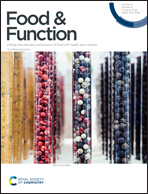Tanshinone IIA protected against lipopolysaccharide-induced brain injury through the protective effect of the blood–brain barrier and the suppression of oxidant stress and inflammatory response
Abstract
Brain microvascular endothelial cells are essential components of the blood–brain barrier (BBB) that acts as a selective physical barrier and plays protective roles in maintaining brain homeostasis. Tanshinone IIA (Tan IIA), isolated from Salvia miltiorrhiza Bunge, exhibited healthy effects such as antioxidant effects, anti-inflammatory effects, and cardiovascular protective effects. Here, we tried to investigate the positive effect and the potential mechanism of Tan IIA on the lipopolysaccharide (LPS)-induced brain injury in mice and brain microvascular endothelial cells in vitro. In vivo, Tan IIA inhibited the brain injury, and the enhancement of blood–brain barrier permeability in the LPS-induced brain injury in mice. Moreover, Tan IIA suppressed inflammatory response and oxidant response in LPS-treated mice evidenced by low levels of serum TNF-α and IL-1β, high superoxide dismutase (SOD) activity and low malondialdehyde (MDA) in the brain. In vitro, Tan IIA suppressed the generation of reactive oxygen species (ROS) and MDA, and promoted SOD activity in LPS-stimulated brain microvascular endothelial cells. Moreover, Tan IIA promoted the expression of Claudin5, ZO-1, Nrf2, HO-1 and NQO1 in LPS-stimulated brain microvascular endothelial cells. In conclusion, Tan IIA protected against the LPS-induced brain injury via the suppression of oxidant stress and inflammatory response and protective effect of the BBB through activating Nrf2 signaling pathways and rescue of the tight junction proteins in microvascular endothelial cells, supporting the application of Tan IIA and Salvia miltiorrhiza Bunge as food supplements for the treatment of brain disease.



 Please wait while we load your content...
Please wait while we load your content...